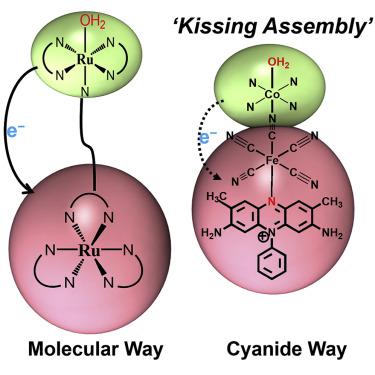Cell Reports Physical Science ( IF 7.9 ) Pub Date : 2021-01-08 , DOI: 10.1016/j.xcrp.2020.100319 Turkan Gamze Ulusoy Ghobadi , Amir Ghobadi , Merve Demirtas , Ruby Phul , Elif Akhuseyin Yildiz , Halime Gul Yaglioglu , Engin Durgun , Ekmel Ozbay , Ferdi Karadas

|
The realization of high-performance, precious-metal-free, stable, and robust photoanodes for water oxidation is one of the bottlenecks for dye-sensitized water splitting. Herein, we integrate an organic photosensitizer, which absorbs visible light above 500 nm, with a Prussian blue (PB) network to sensitize a visible-light-absorbing semiconductor, WO3. Through comprehensive steady-state and ultrafast transient absorption studies, we show that the coupling of a photosensitizer to a catalyst through a short cyanide bridging group in a PB structure generates appropriate energy levels for an efficient charge transfer from the photosensitizer to the visible-light-absorbing semiconductor. The photoanode retains its structural integrity and high photoelectrochemical activity for at least 2 h of solar irradiation under mildly acidic conditions (pH 3), which reaches around 1.30 mA/cm2 at 1.23 VRHE. This work provides a simple recipe with a toolbox that can be extended to a variety of organic photosensitizers and semiconductors.
中文翻译:

通过短的氰化物桥进行水氧化,提高光敏剂与催化剂相互作用的极限
实现高性能,无贵金属,稳定且坚固的水氧化光阳极是染料敏化水分解的瓶颈之一。在这里,我们将有机光敏剂与普鲁士蓝(PB)网络集成在一起,该有机光敏剂吸收500 nm以上的可见光,以敏化可见光吸收性半导体WO 3。通过全面的稳态和超快瞬态吸收研究,我们表明,光敏剂通过PB结构中的短氰化物桥基与催化剂的偶联产生了合适的能级,以实现从光敏剂到可见光的有效电荷转移。吸收半导体。在弱酸性条件下(pH 3),在至少1.23 V RHE下达到约1.30 mA / cm 2的阳光照射下,光阳极至少在2 h内仍保持其结构完整性和高光电化学活性。这项工作为工具箱提供了一个简单的方法,可以扩展到各种有机光敏剂和半导体。











































 京公网安备 11010802027423号
京公网安备 11010802027423号